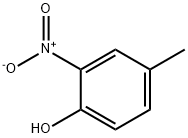CHEMICAL AND PHYSICAL PROPERTIES
| Physical Description | Nitrocresols are yellow-colored crystals. They are slightly soluble in water and weigh more than water. Contact with the material may cause irritation to skin, eyes, and mucous membranes. They are toxic by ingestion or skin contact. They are used to make other chemicals. |
|---|---|
| Vapor Pressure | 0.000632 [mmHg] |
| Kovats Retention Index | 1249.8 1236.4 1241.3 1250 1260 |
| Chemical Classes | Nitrogen Compounds -> Nitrophenols |
SAFETY INFORMATION
| Signal word | Warning |
|---|---|
| Pictogram(s) |
 Exclamation Mark Irritant GHS07 |
| GHS Hazard Statements |
H312:Acute toxicity,dermal H315:Skin corrosion/irritation H319:Serious eye damage/eye irritation H335:Specific target organ toxicity, single exposure;Respiratory tract irritation |
| Precautionary Statement Codes |
P261:Avoid breathing dust/fume/gas/mist/vapours/spray. P305+P351+P338:IF IN EYES: Rinse cautiously with water for several minutes. Remove contact lenses, if present and easy to do. Continuerinsing. |
COMPUTED DESCRIPTORS
| Molecular Weight | 153.14 g/mol |
|---|---|
| XLogP3 | 2.4 |
| Hydrogen Bond Donor Count | 1 |
| Hydrogen Bond Acceptor Count | 3 |
| Rotatable Bond Count | 0 |
| Exact Mass | 153.042593085 g/mol |
| Monoisotopic Mass | 153.042593085 g/mol |
| Topological Polar Surface Area | 66 Ų |
| Heavy Atom Count | 11 |
| Formal Charge | 0 |
| Complexity | 154 |
| Isotope Atom Count | 0 |
| Defined Atom Stereocenter Count | 0 |
| Undefined Atom Stereocenter Count | 0 |
| Defined Bond Stereocenter Count | 0 |
| Undefined Bond Stereocenter Count | 0 |
| Covalently-Bonded Unit Count | 1 |
| Compound Is Canonicalized | Yes |
PRODUCT INTRODUCTION
description
Nitrocresols are yellow-colored crystals. They are slightly soluble in water and weigh more than water. Contact with the material may cause irritation to skin, eyes, and mucous membranes. They are toxic by ingestion or skin contact. They are used to make other chemicals.

